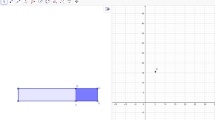Abstract
Dragging in Dynamical Geometry Software (DGS) is described by introducing a hierarchy of its functions. This is suitable for classifying different attitudes and aims of students who investigate a geometric problem, such as exploring, conjecturing, validating and justifying. Moreover the hierarchy has cognitive features and can be used to describe the twofold modulities namely ascending and descending in which students interact with external representations (e.g. Cabri drawings). Switching from one modality to the other through dragging often allows them to produce fruitful conjectures and to pass from the empirical to the theoretical side of the question. The genesis of such different functions in students does not happen automatically but is the consequence of specific didactical interventions of the teacher in the pupils' apprenticeship of Cabri practises. A worked-out example illustrates the theoretical concepts introduced in the paper.
Kurzreferat
Der Text führt eine Funktionshierarchie für den Gebrauch des Zugmodus in Dynamischer Geometrie Software (DGS) ein Diese ist zur Klassifikation von Verhaltensweisen und Zielen der Lernenden geeignet, wenn diese geometrische Problem explorieren, Vermutungen aufstellen, bestätigen und rechtfertigen und dabei theoretische und empirische Aussagen in Cabri-Zeichnungen in Beziehung setzen (wechselweise “auf”-und “absteigen”) Der Wechsel zwischen diesen Sichtweisen unter Nutzung des Zugmodus erlaubt es ihnen oft, gehaltvolle Vermutungen zu formulieren und von einer empirischen zu einer theoretischen Sicht auf das Problem zu wechseln. Der Sichtwechsel stellt sich allerdings nicht automatisch ein, sondern ist die Folge besonderer didaktischer Maßnahmen des Lehrenden. Ein ausgearbeitetes Beispiel illustriert die neu eingeführten theoretischen Begriffe.
Similar content being viewed by others
References
Arzarello F.: 2000, ‘Inside and Outside: Spaces, Times and Language in Proof Production’, in:Proceedings of PME XXIV, Hiroshima, Japan,1, 23–38.
Arzarello, F.: 2001,Dragging, perceiving and measuring physical practices and theoretical exactness in Cabri-environments. Proc. Cabriworld 2, Montreal, Plenary Lecture.
Arzarello, F., Gallino, G., Micheletti, C., Olivero, F., Paola, D. & Robutti, O.: 1998, Dragging in Cabri and modalities of transition from conjectures to proofs in geometry,Proceedings of PME XXII, Stellenbosh, South Africa, v. 2, 32–39.
Arzarello, F., Andriano, V., Olivero, F., & Robutti, O.: 2000, ‘Abduction and conjecturing in mathematics’Philosophica, 1998, 1,61, 77–94.
Bartolini Bussi, M., Boero, P., Ferri, F., Garuti, R., & Mariotti, M.A.: 1997, Approaching geometry theorems in contexts: from history and epistemology to cognition.Proceedings of PMEXXI, Lathi, v. 1, 180–195.
Bottino, R.M. & Chiappini, G.: 1995, ARI-LAB: models, issues and strategies in the design of a multiple-tools problem solving environment,Instructional Science, vol. 23, no1-3, Kluwer Academic Publishers, 7–23.
Hölzl, R. (1995) Between drawing and figure. In: R. Sutherland and J. Mason (Eds.),Exploiting Mental Imagery with Computers in Mathematical Education, Berlin, Springer, 117–124.
Hölzl, R. (1996) How does ‘dragging’ affect the learning of geometry.Intern. Journ. of Computers for Mathematical Learning, 1, 169–187.
Laborde, C.: 1999, The hidden role of diagrams in pupils ‘construction of meaning in geometry’, in: C. Hoyles, J. Kilpatrick (eds.),Meaning and Communication, Kluwer (to appear).
Magnani, L.: 2001,Abduction, Reason and Science, New York, Kluwer Academic.
Mariotti, M. A.: 2001, ‘Influence of technologies advances on students' mathematical learning’, in: English L., Bartolini Bussi M. G., Jones G., Lesh R., & Tirosh D. (eds.)Handbook of International Research in Mathematics Education. Lawrence Erbaum Associates (to appear).
Mariotti, M.A. & Bartolini Bussi, M.G. 1998, ‘From drawing to construction: teacher's mediation within the Cabri environment’,Proceedings of PME XXII, Stellenbosch,3, 247–254.
Noss, R.: 1995, Thematic Chapter: Computers as Commodities. In: diSessa A.A., Hoyles, C., Noss R. (eds.),Computers and exploratory learning, Nato Asi Series F. Vol 146, Berlin, Springer Verlag, 363–381.
Olivero, F.: 1999, ‘Cabri-Géométre as a mediator in the process of transition to proofs in open geometric situations’, in W. Maull & J. Sharp (eds),Proceedings of the 4 th International Conference on Technology in Mathematics Teaching, University of Plymouth, UK.
Olivero, F. 2001, ‘Conjecturing in open geometric situations in a dynamic geometry environment: an exploratory classroom experiment’, In: C. Morgan & K. Jones (eds.),Research in Mathematics Education, London, vol. 3, pp. 229–246.
Olivero, F.: 2002, ‘Proving within dynamic geometry environments’, Ph. D. Thesis, Graduate School of Education, Bristol.
Olivero, F., Paola, D. & Robutti, O.: 2001, Approaching theoretical thinking within a dynamic geometry environment,L'educazione matematica vol. 3, n 3, pp. 127–148.
Pea, R.D.: 1987, ‘Cognitive technologies for mathematics education’. In: A. Schoenfeld, (ed.), Cognitive Science and Mathematical Education, Hillsdale, N.J., LEA Publ., pp 89–112.
Peirce, C.S. (1960)Collected Papers, II. Elements of Logic, Harvard, University Press.
Perkins, D.N.: 1993, Person-plus a distributed view of thinking and learning’ In: G. Salomon (ed),Distributed cognitions, Cambridge, Cambridge Univ. Press, pp. 88–110.
Polya, G.: 1954,Mathematics and Plausible Reasoning. Princeton, NJ: Princeton Univ. Press.
Saada-Robert, M.: 1989, ‘La microgénèse de la rapresentation d'un problème’.Psychologie Française, 34, 2/3.
Vygotsky, L.S.: 1978, Mind in Society. The development of Higher Psychological Processes, Harvard University Press.
Author information
Authors and Affiliations
Rights and permissions
About this article
Cite this article
Arzarello, F., Olivero, F., Paola, D. et al. A cognitive analysis of dragging practises in Cabri environments. Zentralblatt für Didaktik der Mathematik 34, 66–72 (2002). https://doi.org/10.1007/BF02655708
Issue Date:
DOI: https://doi.org/10.1007/BF02655708




